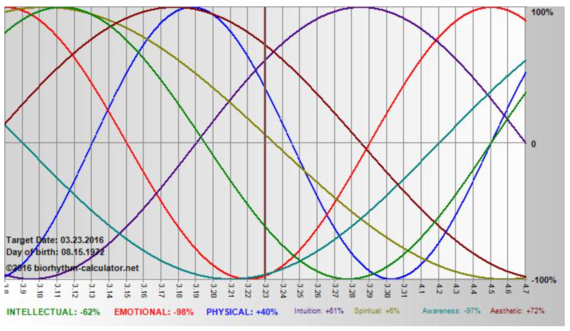Who remembers biorhythms? I do. I was about nine when biorhythm was all the rage, peaking in the mid to late 1970s in North America. Conterminous to a society which sported mood rings, cowl necks, platform shoes, culottes and feathered hair, biorhythms took hold of North America. Briefly biorhythms is a pseudoscientific belief that our lives are affected by cycles elided by science which accounts for circadian rhythms (sensitivity to light and dark) or biochronometry (the study of time in living organisms). Biorhythms exclude scientific study and method and is based principally on numerology and the Forer effect (also called the Barnum effect) for which people rate highly the accuracy of descriptions which superficially sound precise, but are generally so vague that they could apply to just about everyone (ie. similar to astrological readings).
To get an idea as to how a biorhythm is determined, just try any number of biorhythm calculators available online. The only empirical data needed is one's birthdate and presto zippo you can have a zany coloured graph which shows you, for any given date--past, present, or future--a biorhythm which makes absolutely no sense, having zero scientific basis. Gyre-like lines that look scientific accompanied by numbers extended onto a horizontal plane say nothing at all except that my emotional level is -90%, my intellectual +99%, and my spiritual +74%. (Good news on the intellectual front or I might not be able to read the chart or write this article!) What these numbers mean is precisely what mercury in retrograde means, scientifically speaking that is: absolutely nothing.

Yet so many of us are not only willing, some of us are downright desperate to have order read into our lives. Where biorhythms served the individual in the1970s when society had thrown away strict notions of empiricism, the illogic and pretty lines of biorhythms allowed the subject to subjectively render any interpretation as true. Following this fad were the self-empowerment programs like Est and the Jane Fonda workout which took over the mind and body in the 1980s. The decade of Reaganomics was in full swing and notions of personal responsibility, accountability, and possibility were married to the absolute control of the body. Biorhythms which ushered forth colourful linear patterns set within vague-sounding nomenclature and random numbers were quickly pushed aside by those in favour of Olivia Newton John-styled head bands and leotards.
One could argue that the current day fads of self-empowerment are taking place almost uniquely through the combined forces of the personal computer and Internet where individuals seek virtual forms of authentication. Over the past two decades many individuals have learned how to use computers and navigate the Internet, others have taken great efforts to learn how to host their own websites in order to blog, while even greater multitudes gravitate more towards social media where it is not content creation that moves them, but rather the virtual interaction with others from whom the subject feels empowered, even validated. As some might look skeptically towards biorhythms as a form of reading the self forty years ago, one could just as easily cast aspersions on social media and personal blogs which often become echo chambers for the like-minded to spend their time reassuring the other of their "righteousness" or, conversely, to shout down and ridicule those in disagreement. Freud's mirror stage of the toddler can easily be reread through virtual communities where the need for validation and affirmation becomes paramount to all communication. It could even be said that such validation precedes communication.
Today, looking to biorhythms as some outdated, ineluctable fact of our collective past, it is interesting to cogitate its relationship to our present. For instance, what if we owe our technological advancement and our virtual communities to the fact of this frivolous, if not bizarre, phase of having had our biorhythms charted in order to give a sense of meaning and direction to our lives? We might even begin to wonder if our virtual interactions online lend us any more sense of direction to our lives today over the random and inaccurate readings that biorhythms brought forth. Or maybe both are simply about the interactions--real or fiction, scientifically proven or hokum--which compel us to continue in a discussion over a topic that will not actually or immediately bring relief to our lives. Perhaps, like the mood ring which turns blue from green, we are there for the spectacle?
